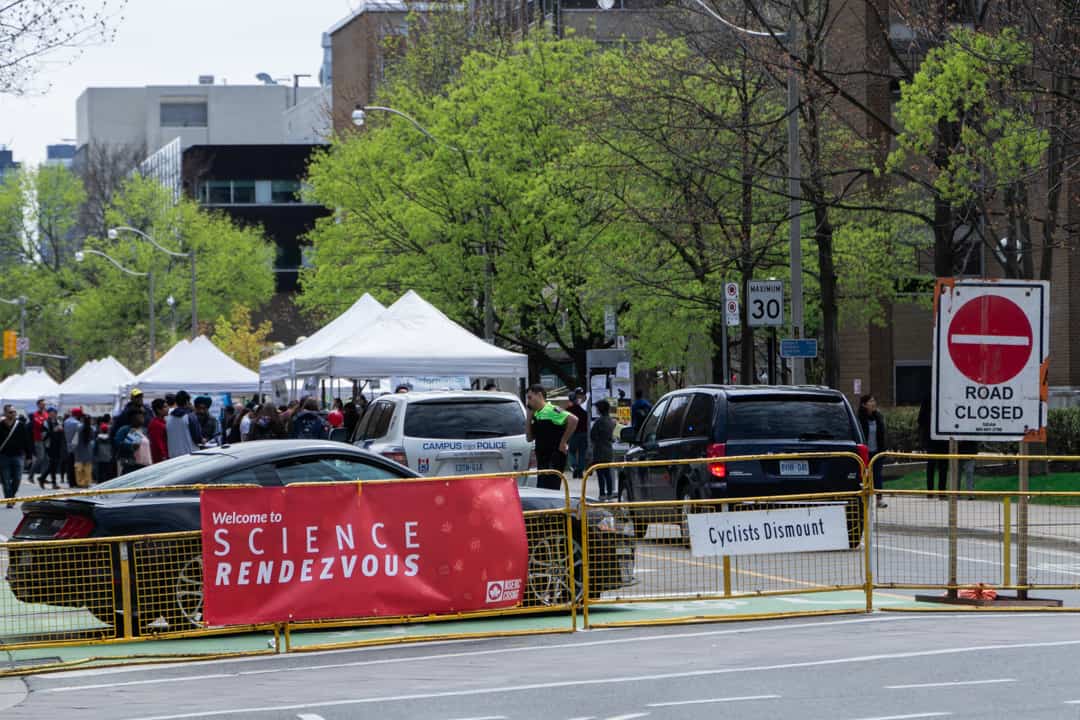On a cloudy afternoon on May 11, professors, students, parents, and children enjoyed the annual Science Rendezvous street festival at U of T’s St. George campus. The event let them celebrate and learn more about advancements and achievements in research.
The unifying theme of the festival this year was “S.T.E.A.M Big!”, which focused on the intersections between science, technology, engineering, art, and mathematics (STEAM). While art is often seen as separate from STEM disciplines, it is becoming increasingly common in the scientific community to encourage taking inspiration from the arts to drive innovative research.
Street stalls and displays exhibited the relationship between art and science
Displays that exemplified the relationship between art and science included outdoor music and dancing, as well as a visual art gallery inspired by math and science.
The focal points were the stalls and displays lining all of St. George Street. These exhibits presented some of the hottest topics and projects in science today, focusing on big interdisciplinary innovations found at the intersections of these rapidly advancing fields.
Over 80 faculties and community organizations set up exhibits. Highlights included displays of solar-powered cars, rockets, robots, and a wide array of other projects that would fascinate even those who have a passing interest in scientific inquiry.
This wide range and diversity of subjects represented by the participating volunteers brought the 2019 theme of STEAM to vibrant life.
Booths and demonstrations were highlights of the festival
The street festival included over 100 fascinating and interactive booths. Some leaned toward the classic science fair vibe, such as displaying glowing bacteria and allowing patrons to look through a solar telescope. Others opted to take a more creative approach, such as the station inviting attendees to paint with acids, bases, and plant juices.
Some displayed student innovations, such as the demonstration set up by U of T Blue Sky Solar Racing, an undergraduate team that designs, builds, and races solar powered vehicles. There was also a plethora of digital demonstrations interspersed between all the other projects, ranging from virtual reality tours of archeological sites to demos of the many student-made video games.
Street fairs like Science Rendezvous increase engagement with science
One of the goals of the festival was to raise interest in U of T’s science programs, as many high school students attended and participated in the event. An example was the molecular genetics-focused science fair that took place in Bahen Centre for Information Technology.
Besides attracting prospective students, the festival is intended to improve public involvement and investment in STEAM fields. From the number of students competing in the science fair, sporting U of T shirts with palpable excitement on their faces, to the sizeable crowds drawn in by the street festival, it is safe to say that both of these goals were achieved.
A rendezvous is a meeting or an appointment. In a way, St. George Street is a science rendezvous every day, with labs, classes, and seminars running regularly. What was special about this festival was that it took experiences that are often inaccessible and presented them in a way that could appeal to all.
The pretension and exclusivity that often seems to follow research was stripped away, and all that was left was mystery, excitement, and curiosity. This contributed to why the event drew in hundreds of people, and why volunteers and attendees come back year after year.


